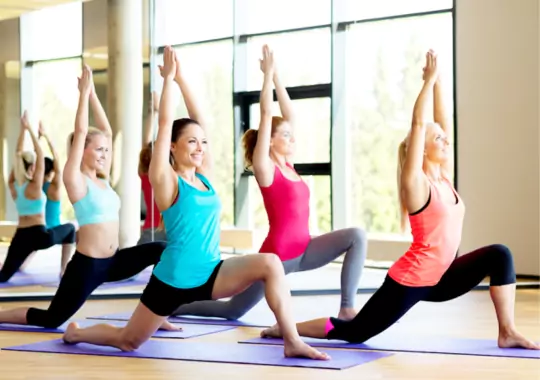Are you curious about yoga and its many facts? Yoga is a holistic practice that encompasses physical postures, breathing techniques, meditation, and ethical principles. In this article, we'll explore some fascinating facts about yoga, shedding light on its rich history, diverse styles, and profound benefits.
As Amazon affiliates we may earn a commission if you purchase a product at no cost to you.
Yoga's Ancient Roots
Yoga's origins can be traced back over 5,000 years to ancient India, where it emerged as a comprehensive system for physical, mental, and spiritual well-being. The word "yoga" itself was first mentioned in the sacred texts known as the Rig Veda, indicating its significance in ancient Indian culture.
Initially, yoga was developed as a means to achieve spiritual enlightenment and deepen one's understanding of the universe and the self. Over time, it evolved into a multifaceted practice that encompasses various techniques, including physical postures (asanas), meditation, breath control (pranayama), chanting (mantra), and ethical principles for living a meaningful life.
The ancient yogis recognized the interconnectedness of the body, mind, and spirit and developed yoga as a way to harmonize these aspects of human existence. Through the integration of physical movements, breath awareness, and mental concentration, practitioners sought to cultivate inner peace, balance, and spiritual growth.
Yoga's ancient roots reflect a deep reverence for the natural world and the human capacity for self-awareness and transformation. It continues to inspire millions of people worldwide as a path to self-discovery, inner peace, and holistic well-being.

Yoga for All
Yoga's accessibility has evolved significantly over time, initially being dominated by male practitioners. However, the landscape changed when revered teacher Krishnamakariri permitted his wife to join yoga practices, marking a shift towards inclusivity. This trend continued with the emergence of Broga, a yoga style tailored to men's needs, further broadening yoga's reach.
Today, yoga is celebrated as a practice that welcomes individuals of all genders, ages, body types, and backgrounds. Its universal appeal lies in its adaptability and the multitude of styles available, ensuring that everyone can find a practice that suits their needs and preferences. Yoga's evolution towards inclusivity reflects its commitment to promoting holistic well-being for all.
Diverse Styles of Yoga
Yoga encompasses over 100 different schools, catering to various preferences and needs. From traditional forms like Hatha to innovative practices such as laughter yoga and paddleboard yoga, there's a style suited for everyone. Each yoga style emphasizes distinct techniques and philosophies, providing practitioners with a range of options to explore and benefit from.
Whether one seeks physical fitness, mental relaxation, spiritual growth, or a combination of these, there's a yoga style tailored to meet those goals. The diversity of yoga styles reflects its adaptability and inclusivity, making it accessible to people of all ages, fitness levels, and backgrounds.
Yoga and Age
Yoga's benefits transcend age barriers, as exemplified by Tao Porchon-Lynch, who became the world's oldest yoga instructor at 93. This achievement showcases that yoga is not limited by age and can be practiced by individuals of all ages, from children to seniors. The practice of yoga offers numerous physical, mental, and emotional benefits that are accessible to people at every stage of life.
For seniors specifically, yoga can improve flexibility, strength, balance, and overall well-being. Moreover, studies indicate that yoga can help lower blood pressure, reduce stress, and promote the release of feel-good chemicals, contributing to improved health and vitality at any age.
Additionally, yoga has been shown to positively impact cellular aging, mobility, balance, and mental health, further underscoring its relevance for healthy aging. Overall, yoga's adaptability and holistic approach make it a valuable practice for individuals seeking to maintain their well-being and vitality throughout their lives.

Yoga and Sexual Wellness
Enhancing Circulation and Awareness
Yoga practices, including engaging Mula Bandha, improve blood flow to intimate areas, enhancing sensitivity and arousal. Increased awareness fosters a deeper connection with one's body and sensations, leading to more fulfilling sexual experiences.
Reducing Stress and Anxiety
Regular yoga practice reduces stress levels, which can inhibit sexual arousal and satisfaction. By calming the mind and promoting relaxation, yoga creates a conducive environment for intimacy and enhances overall sexual wellness.
Improving Flexibility and Strength
Yoga improves flexibility and strengthens muscles, including those in the pelvic floor, which are crucial for sexual health. Enhanced flexibility allows for a wider range of motion during sexual activity, while increased strength supports endurance and stamina.
Heightening Sensory Awareness
Yoga cultivates mindfulness and sensory awareness, enabling individuals to fully experience intimate moments with themselves and their partners. By tuning into sensations and emotions, practitioners can deepen intimacy and pleasure, leading to a more satisfying sexual life.
Fostering Emotional Connection
The holistic approach of yoga promotes emotional balance and self-awareness, facilitating deeper emotional connections with oneself and one's partner. By addressing emotional barriers and promoting open communication, yoga enriches relationships and enhances sexual wellness.
Recommended Article

Frequently Asked Questions (FAQs)
What is the difference between yoga and other forms of exercise?
Yoga is unique in that it combines physical postures (asanas) with breathing techniques, meditation, and ethical principles. While other forms of exercise primarily focus on physical fitness, yoga aims to promote overall well-being by integrating the body, mind, and spirit.
Can anyone practice yoga, regardless of age or fitness level?
Yes, yoga is accessible to people of all ages and fitness levels. There are various styles and modifications available to suit individual needs, making it a versatile practice for everyone. Whether you're a beginner or an experienced yogi, there's a yoga practice that can benefit you.
What are some of the benefits of practicing yoga regularly?
Practicing yoga regularly can have numerous benefits, including improved flexibility, strength, and balance. It can also help reduce stress, anxiety, and depression, while promoting relaxation and mental clarity. Additionally, yoga has been shown to improve sleep quality, boost immunity, and enhance overall physical and mental well-being.
Conclusion
Yoga is much more than just a physical exercise; it's a lifestyle that nurtures the body, mind, and spirit. From its ancient origins to its modern evolution, yoga continues to inspire millions around the world with facts about yoga. By practicing yoga into your daily routine, you can experience its numerous benefits, such as improved flexibility, reduced stress, and a greater sense of inner peace.










